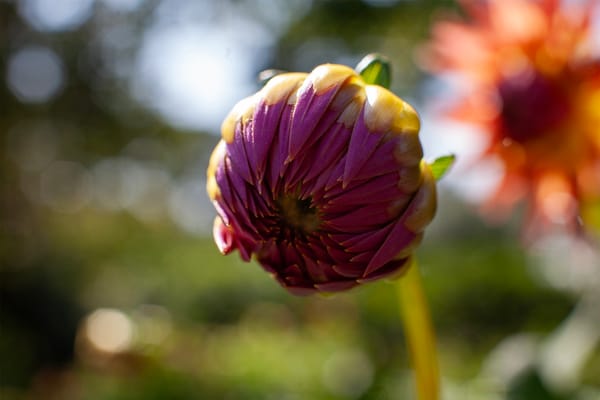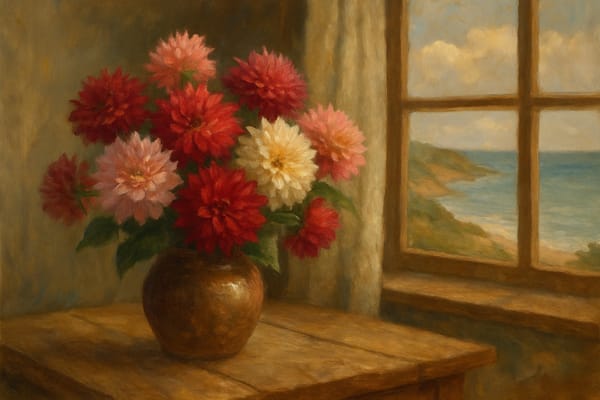For every towering, vibrant dahlia that lights up a Cornish garden in late summer, there’s an unseen world beneath the surface—and within each stem—that tells a story of structure, resilience, and genetic complexity. To the seasoned gardener, especially in Cornwall’s blustery, unpredictable climate, understanding what gives a dahlia its upright grace is more than a curiosity—it’s a necessity. Here’s a deep dive into the hidden science of dahlia stem strength, the secrets breeders chase, and how we as growers work with nature’s blueprint.
Beneath the Skin: The Cellular Strength of Dahlia Stems
The upright nature of a dahlia, especially those bearing dinner-plate-sized blooms, depends on a sophisticated internal architecture. On the surface, the epidermis forms the protective skin, a barrier against pests and dehydration, but also offers a surprising amount of tensile support—especially when the plant is young.
Just beneath, collenchyma cells take the stage. These living support cells, with walls thickened by cellulose and pectin, are the first responders against bending and snapping. They allow flexibility—essential for surviving coastal gusts—but they also brace the stem as it stretches upward.
Further inside, the vascular bundles run in elegant rings, a structural choice that reinforces the stem’s strength against compression and flexing. The xylem within these bundles, fortified with lignin, serves as both the plant’s water highway and its skeleton. Lignin acts like plant armor—imparting rigidity, preventing collapse under weight, and resisting damage from wind.
Cellulose remains the unsung hero, present in all cell walls, giving tensile strength and a spring-like resistance that balances flexibility with firmness. Binding it all together is calcium pectate, the ‘cement’ of the plant world, ensuring cells stay unified under strain.
And at the heart of it all? The parenchyma and pith. While these cells mainly store water and nutrients, in dahlias they can sometimes be hollow or air-filled—reducing weight but demanding that the surrounding structures pull their weight in rigidity.
Genetics in the Garden: Why Some Dahlias Stand Tall—and Others Flop
For those selecting dahlias for breeding or border planting, stem strength is not just luck—it’s lineage. Studies into dahlia genetics reveal that stem diameter, length, and rigidity are highly heritable traits governed by additive gene action. In simpler terms: what you see in a parent plant is likely to show in its offspring.
Stem diameter isn’t merely aesthetic. Thicker stems equate to greater mechanical strength. Yet, interestingly, there’s often a genetic trade-off—very large flowers may correlate negatively with stem strength. Breeders walk a fine line here, balancing breathtaking bloom size with the stem’s capacity to hold it aloft.
Dahlias’ octoploid nature (eight copies of each gene) complicates but also enriches this selection process. With high heritability estimates for traits like stalk length and diameter, breeders can make reliable, rapid gains by selecting strong-stemmed parent lines. Each cross and generation refines this delicate equilibrium between bloom grandeur and structural stamina.
Wind, Weather, and the Wisdom of Stakes
In Cornwall, where coastal winds can humble even the hardiest plants, growers have learned that staking is both art and science. While traditional canes suffice in sheltered plots, exposed gardens demand robust support systems:
- Corral Systems: Strong corner posts with horizontal ropes or twine encircle groups of dahlias, letting plants lean together and absorb wind stress collectively.
- Horizontal Netting: Commercial flower netting stretched over beds at staggered heights cradles stems and prevents the dreaded midseason flop.
- Cross-Rope Grids: A flexible web of string or twine above the planting area disperses wind load across multiple axes, protecting against snapping and lodging.
The golden rule? Always install supports early, before growth demands them—particularly when the season’s first Atlantic gales roll in.
Breeding for Strength: The New Frontier
Global breeding programs, including work in Britain and the Netherlands, are actively selecting for thicker stems, upright habits, and improved lignification. While traditional selection remains the backbone, some breeders employ mutation techniques to discover novel strength traits, refining these lines over multiple generations.
With advances in genomic mapping on the horizon, breeders anticipate being able to pinpoint exact genetic markers linked to stem durability. This would accelerate the process dramatically, offering a future where choosing a dahlia isn’t just about colour or form—but also about engineered strength.
The Impact of Wind on Growing Choices
Wind exposure alters not just how we stake our dahlias, but how we select, site, and companion plant them. In windy Cornish plots:
- Growers opt for robust, ball-type or dark-leaved dahlias over towering dinner-plates in the most exposed beds.
- Companion planting with sturdy grasses or perennials provides a natural windbreak and reduces stem strain.
- Microclimate planting—nestling dahlias into dips, behind walls, or within sheltered borders—lets nature do some of the work.
Even tying techniques adapt: soft, stretchy ties allow stems to flex without damage, and multiple points of support across a plant’s height distribute stress more effectively.
The Art of Standing Tall
Ultimately, a dahlia’s ability to stand proud in a Cornish garden isn’t just a quirk of chance or the luck of the weather. It’s a symphony of cellular structure, genetic inheritance, clever cultivation, and thoughtful breeding. As we learn more about what makes a dahlia robust—from its lignified xylem to its pectin-bonded cells—we can grow and breed with greater precision and respect for the elegant mechanics at play.
For the advanced gardener, this knowledge becomes part of the craft—a deeper understanding that transforms staking from a chore into an art, and plant selection into a science. And in a world where wind, bloom size, and nature’s whims all collide, that knowledge makes all the difference between a dahlia that flops… and one that stands as a beacon of beauty against a Cornish sky.











